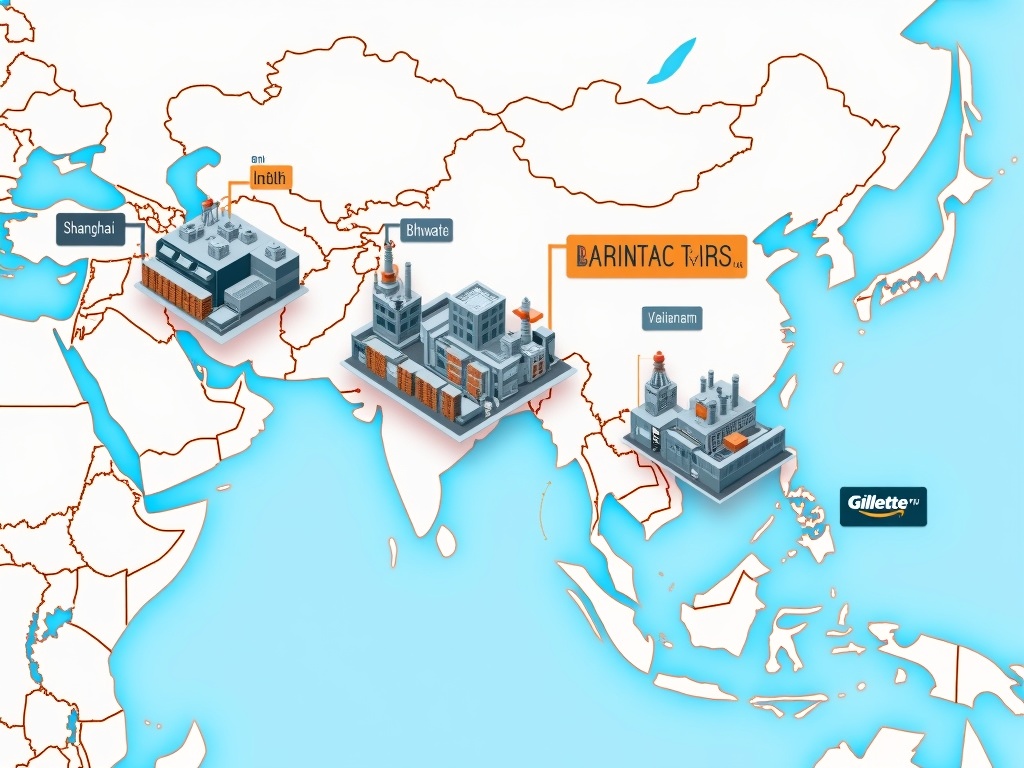No products in the cart.
For men, Gillette, Personal Care News
Where Is Gillette Razors Made Across Continents
Gillette runs a sophisticated global manufacturing network that spans multiple continents. Production facilities stretch from its flagship South Boston headquarters to specialized plants across Europe, Asia, and Mexico. The company’s manufacturing strategy balances innovation hubs in developed markets with cost-effective production centers in emerging economies. This approach allows Gillette to serve diverse consumer segments while maintaining consistent quality standards worldwide.
Table of Contents
Key Takeaways
- North America serves as innovation headquarters with the South Boston facility functioning as the “World Shaving Headquarters” employing 1,500 people, while Mexico’s Irapuato plant handles high-volume disposable razor production
- European operations emphasize precision engineering with Germany’s Berlin facility producing premium “Made in Germany” blades since 1937, and Poland’s Lodz plant operating as the largest European factory following a $150 million investment
- Asian manufacturing focuses on regional market adaptation including China’s Shanghai plant for premium products, India’s Bhiwadi facility producing the specially-designed low-cost Gillette Guard, and Vietnam’s operations serving both local and export markets
- Specialized facilities create an interconnected supply chain where components from multiple continents combine into final products, with Boston handling R&D and premium blades while other locations focus on handles, packaging, and regional assembly
- Strategic facility placement optimizes costs and market access by positioning production near target consumers, leveraging regional strengths like German engineering reputation, and providing geographic risk mitigation across the global manufacturing network
Gillette’s Manufacturing Empire: From Boston to Global Facilities
I can trace Gillette’s manufacturing roots back to 1905 when King C. Gillette established what would become the company’s flagship facility in South Boston. This location serves as the “World Shaving Headquarters” and remains the nerve center for blade innovation more than a century later.
South Boston: The Innovation Powerhouse
The South Boston facility stands as Gillette’s primary manufacturing and research hub. I observe that this massive complex employs approximately 1,500 people who produce billions of blades annually. The facility specializes in manufacturing advanced cartridge systems including the Fusion5, ProGlide, and SkinGuard product lines.
Advanced manufacturing processes define the South Boston operation. The facility utilizes cutting-edge technologies such as laser welding and precision blade alignment to ensure each cartridge meets exacting standards. These sophisticated processes enable Gillette to maintain consistency across millions of units while incorporating the latest innovations in shaving technology.
Expanding Beyond Massachusetts
While South Boston handles the core blade manufacturing, Gillette has strategically distributed other production elements across different locations. The Andover, Massachusetts facility focuses specifically on shaving preparations, producing the gels and foams that complement Gillette’s razor systems.
This dual-location approach in Massachusetts allows Gillette to maintain tight quality control while optimizing production efficiency. The proximity between facilities enables seamless coordination between blade development and complementary product creation. I find that this strategic positioning strengthens Gillette’s ability to integrate innovations across their entire product ecosystem.
The South Boston facility’s designation as headquarters reflects its central role in Gillette’s manufacturing process. From initial concept development through final production, this location drives the technical advancement that has kept Gillette at the forefront of shaving technology for over a century.
Beyond these Massachusetts operations, Gillette has expanded its manufacturing footprint globally to serve international markets efficiently. The company operates manufacturing facilities across multiple continents, ensuring product availability while maintaining the quality standards established at their flagship location.
Each facility in Gillette’s network maintains the same rigorous manufacturing standards pioneered in South Boston. This consistency ensures that whether a razor is produced in Massachusetts or at one of their global manufacturing locations, consumers receive the same level of quality and performance that has defined the Gillette brand since its inception.
European Production Centers: Precision Engineering and Scale
Europe stands as a cornerstone of Gillette’s global manufacturing network, housing some of the company’s most advanced and productive facilities. I’ve observed how these European centers combine decades of engineering expertise with cutting-edge technology to deliver razors that meet the brand’s exacting standards.
Germany’s Legacy of Premium Manufacturing
The Berlin facility represents Gillette’s longest-running European operation, having produced premium razor blades since 1937. This plant specializes in high-end products that proudly bear the “Made in Germany” stamp, reflecting the country’s reputation for precision manufacturing. German engineering principles continue to influence production standards across Gillette’s European network, ensuring consistent quality that consumers have come to expect from German-made razors.
Poland’s Manufacturing Powerhouse
The Lodz facility in Poland has emerged as Gillette’s European manufacturing giant and represents one of the largest razor blade factories globally. P&G has designated this location as their largest European factory and second-largest worldwide, underscoring its strategic importance. Recent investments totaling nearly $150 million have transformed this facility into a state-of-the-art production center, incorporating advanced automation and quality control systems.
This substantial investment reflects P&G’s commitment to European manufacturing and positions Lodz as a critical hub for serving both European and international markets. The facility’s scale allows for high-volume production while maintaining the precision engineering standards that define top-tier manufacturing facilities.
The UK’s Reading location has transitioned from traditional manufacturing to focus primarily on research and development activities. This facility now works alongside Boston headquarters to drive innovation in razor technology, blade design, and manufacturing processes. By concentrating on R&D, Reading supports the entire European production network with technical expertise and product development capabilities.
European production sites consistently emphasize precision engineering principles that have made German and European manufacturing synonymous with quality. These facilities leverage high-volume efficiency techniques while maintaining strict quality controls. The combination of traditional craftsmanship values with modern manufacturing technology creates products that meet both performance and durability standards.
Each European facility contributes unique strengths to Gillette’s global supply chain:
- Germany provides premium manufacturing heritage
- Poland delivers massive production capacity with recent technological upgrades
- The UK focuses on innovation support
This distributed approach ensures production flexibility while maintaining consistent quality across all European manufacturing locations.

Asian Manufacturing Hubs: Meeting Regional Demand
P&G has established a formidable manufacturing presence across Asia, strategically positioning facilities to serve the region’s diverse shaving needs and economic requirements. I find the company’s approach particularly impressive in how it balances global efficiency with local market adaptation.
Strategic Facility Locations and Specializations
The Shanghai, China plant serves as the primary supply hub for the vast Asian market, focusing on premium products like the Mach3 razor system. This facility leverages China’s advanced manufacturing infrastructure and skilled workforce to produce high-volume quantities that meet demand across multiple Asian countries.
Moving south, the Bhiwadi, India facility represents a masterclass in localized product development and manufacturing. Here, P&G produces the Gillette Guard, a specially designed low-cost razor that addresses the specific needs and purchasing power of Indian consumers. The Guard’s development story showcases impressive innovation — requiring over $50 million in research and development investment. This substantial financial commitment paid off significantly, as the product subsequently won multiple design awards for its effectiveness and affordability.
Vietnam’s manufacturing operations have become increasingly important for P&G’s Asian strategy. The Binh Duong facility produces both disposable razors and cartridges, serving dual purposes of meeting local Vietnamese demand while also functioning as an export hub for neighboring markets. The company’s confidence in this region shows through its substantial investment — P&G has committed over $300 million to its Vietnam operations, demonstrating the strategic importance they place on this manufacturing base.
Each facility operates with distinct specializations that reflect both local market conditions and global supply chain efficiency:
- China: Emphasizes high-volume production of premium products for affluent Asian markets.
- India: Focuses on cost-effective manufacturing processes that enable competitive pricing for price-sensitive consumers.
- Vietnam: Balances local needs with export capabilities, particularly important given the country’s growing role in global manufacturing networks.
These Asian manufacturing hubs work together to create a comprehensive supply network that can respond quickly to regional demand fluctuations while maintaining quality standards. The facilities share technology and best practices, ensuring consistent product quality regardless of manufacturing location. This interconnected approach allows P&G to optimize production costs while maintaining the flexibility to serve diverse market segments effectively.
I observe that P&G’s substantial investments in these Asian facilities reflect broader trends in consumer goods manufacturing. The company recognizes that Asian markets require both local adaptation and world-class manufacturing capabilities. By establishing specialized facilities that can serve both local and regional markets, P&G has created a manufacturing network that supports sustainable growth across one of the world’s most dynamic economic regions.
The success of products like the Gillette Guard demonstrates how effective local manufacturing can be when combined with significant research and development investment. This model has proven particularly valuable in emerging markets where consumers demand quality products at accessible price points.

North American Manufacturing Beyond Boston
Gillette’s manufacturing footprint extends well beyond its famous Boston headquarters, with strategic facilities designed to serve different market segments across North America. The company operates two primary production centers that complement each other: a high-volume facility in Mexico and an advanced technology hub in Massachusetts.
Irapuato, Mexico: High-Volume Production Hub
I’ve found that Gillette’s Irapuato plant serves as the backbone for disposable razor production across North and Latin American markets. This facility specializes in manufacturing popular models like the Sensor and Daisy razors, focusing on high-volume, cost-effective production. The plant also produces essential plastic components that support Gillette’s broader product lines.
The Irapuato facility operates with a clear mission: delivering affordable shaving solutions without compromising quality. By concentrating on disposable razors and plastic manufacturing, this plant allows Gillette to maintain competitive pricing while meeting the massive demand from both domestic Mexican markets and export destinations. This strategic positioning makes the facility crucial for Gillette’s global supply chain, particularly for cost-conscious consumers who prefer disposable options over premium cartridge systems.
Andover, Massachusetts: Technology and Innovation Center
The Andover facility represents Gillette’s commitment to cutting-edge manufacturing technology and innovation. This Massachusetts plant stands as one of Procter & Gamble’s largest technology-driven manufacturing sites, focusing on advanced production processes and quality control systems.
In 2017, P&G demonstrated its confidence in American manufacturing by investing over $200 million in U.S. manufacturing sites, including significant upgrades to the Andover facility. This investment highlights the plant’s importance in Gillette’s long-term strategy and its role in producing premium razor lines that require sophisticated manufacturing capabilities.
I’ve observed that Andover’s operations complement the high-volume production in Mexico by focusing on premium products that demand precise engineering and advanced materials. This division of labor allows Gillette to optimize costs while maintaining the quality standards that consumers expect from their premium razor lines. The facility’s emphasis on technology also supports research and development initiatives, ensuring that new innovations can quickly transition from concept to mass production.
The strategic relationship between these facilities creates a powerful manufacturing network. While Irapuato handles the bulk of disposable production for price-sensitive markets, Andover concentrates on technology-intensive products that command higher margins. This approach allows Gillette to serve diverse consumer segments effectively while maintaining operational efficiency across their manufacturing network.
Both facilities benefit from P&G’s global supply chain expertise, sharing best practices and technological advances. The Irapuato plant’s efficiency improvements often translate to cost savings that benefit the entire product line, while Andover’s technological innovations can be adapted for implementation in other facilities worldwide. This synergy between high-volume production and advanced technology represents a key competitive advantage for Gillette in the highly competitive shaving market.

How Gillette’s Global Supply Chain Works
Gillette operates through an interconnected manufacturing web rather than isolated facilities scattered across different regions. This integrated approach allows the company to leverage each location’s unique strengths while maintaining consistent quality standards across all products.
Component Sourcing and Assembly Strategy
High-tech blades often originate from Boston or Berlin facilities, while handles come from manufacturing centers in Mexico or Poland. Final assembly frequently occurs closest to the target market for maximum efficiency and reduced shipping costs. This strategic distribution means a single package on your shelf likely includes components from multiple continents.
The supply chain operates on a hub-and-spoke model where specialized components travel to regional assembly centers. Advanced blade technologies developed in Boston might pair with precision-molded handles from Polish facilities before final packaging in local distribution centers. This approach reduces transportation costs while ensuring each component receives specialized manufacturing attention.
Specialized Manufacturing Centers
Each Gillette plant maintains a defined specialty that contributes to the overall production network. The following facilities demonstrate this specialized approach:
- Boston handles research and development alongside premium blade production
- Berlin focuses on European cartridge manufacturing and regional distribution
- Lodz manages mass production operations for cost-effective manufacturing
- Bhiwadi specializes in affordable innovations for emerging markets
Boston’s facility serves as the innovation hub where cutting-edge razor technologies first take shape. Engineers and designers work alongside production teams to ensure new concepts translate effectively into manufacturable products. This manufacturing process maintains strict quality controls from initial concept through final production.
Berlin’s operations focus heavily on serving European markets with locally-relevant products and packaging. The facility adapts global designs for regional preferences while maintaining Gillette’s quality standards. Production scheduling aligns with European demand patterns to minimize inventory costs and delivery times.
Poland’s Lodz facility excels in high-volume production capabilities. This center produces millions of units monthly using automated systems that ensure consistency across large production runs. The facility’s strategic location provides efficient access to both Western and Eastern European markets.
India’s Bhiwadi plant concentrates on developing cost-effective innovations specifically for price-sensitive markets. Engineers at this facility redesign existing technologies to reduce manufacturing costs without compromising core functionality. These innovations often influence global export strategies as cost-effective solutions prove valuable in multiple markets.
The interconnected nature of this supply chain creates flexibility during disruptions. If one facility experiences capacity constraints, production can shift to alternative locations with similar capabilities. Raw materials and components move between facilities based on demand forecasts and production schedules rather than fixed allocation patterns.
Quality control systems operate across all facilities using standardized testing protocols. Each location maintains identical quality standards regardless of the specific products manufactured. This consistency ensures consumers receive the same experience whether their razor components originated from facilities worldwide or from a single regional center.
Inventory management systems coordinate between facilities to optimize stock levels and reduce waste. Advanced forecasting models predict demand patterns across different regions, allowing production schedules to align with market needs. This coordination minimizes overproduction while ensuring adequate supply for peak demand periods.
The global supply chain also enables rapid deployment of new technologies. Innovations developed in Boston can quickly scale to manufacturing facilities in other regions through standardized production processes and shared technical documentation. This capability accelerates time-to-market for new products across multiple geographic regions simultaneously.
Transportation logistics connect these facilities through established shipping routes and partnerships with global carriers. Components move efficiently between production stages using optimized routing that considers both cost and delivery timeframes. This logistics network ensures smooth material flow even when components cross multiple international borders during production.
The Business Strategy Behind Gillette’s Locations
I’ve studied Gillette’s manufacturing strategy extensively, and their facility placement reflects sophisticated business planning that goes far beyond simple cost reduction. Plants are strategically positioned near key markets to reduce shipping costs while maximizing operational efficiency across different consumer segments.
Strategic Market Proximity and Specialized Operations
Gillette’s approach centers on placing specialized facilities close to their primary consumer bases. This proximity strategy cuts transportation expenses while enabling faster response times to market demands. Each facility maximizes efficiency through focused production lines that maintain consistent global quality standards regardless of location.
The company operates innovation hubs in Boston and Reading that influence processes worldwide. These research centers develop new technologies and manufacturing techniques that get distributed across the global network. I’ve observed how these hubs serve as the backbone for maintaining Gillette’s competitive edge in razor technology.
Different regions serve distinct strategic purposes within Gillette’s global framework:
- Emerging market plants in India and Vietnam focus on cost-effective, localized products that meet price-sensitive consumer needs. These Vietnam export operations demonstrate how Gillette balances affordability with quality for developing markets.
- European plants leverage the region’s engineering reputation to reinforce brand trust among premium consumers. German precision and European quality standards become selling points that justify higher price points in developed markets. This geographic branding strategy helps Gillette position different product lines appropriately.
The global network ensures Gillette adapts to both premium and mass-market demands simultaneously. High-end facilities in developed countries produce premium products with advanced features, while cost-optimized plants in emerging markets focus on essential functionality at competitive prices. This dual approach allows Gillette to capture market share across economic segments.
I’ve noticed how this location strategy also provides risk mitigation through geographic diversification. Supply chain disruptions in one region don’t halt global production since manufacturing operations span multiple continents. This redundancy protects against natural disasters, political instability, or trade disputes that might affect specific locations.
The strategic placement extends beyond manufacturing to include regulatory considerations. Different regions have varying safety standards and import requirements. By producing locally or regionally, Gillette reduces compliance complexity while avoiding potential trade barriers that could impact product availability.
Labor cost optimization plays a significant role in facility selection, but Gillette balances this with quality requirements. Lower labor costs in certain regions enable competitive pricing for mass-market products, while skilled workforces in developed countries support premium product lines requiring precision manufacturing.
Technology transfer between facilities ensures consistent innovation implementation across the network. New manufacturing processes developed in innovation hubs get systematically rolled out to production facilities worldwide. This approach maintains quality standards while allowing for regional customization when needed.
The location strategy also supports Gillette’s brand positioning in different markets. Products manufactured in countries with strong quality reputations benefit from positive country-of-origin effects. Consumers often associate certain manufacturing locations with superior quality, which Gillette leverages through strategic production placement.
Environmental considerations increasingly influence location decisions as well. Facilities in regions with stricter environmental regulations often develop cleaner production methods that eventually spread across the network. This proactive approach helps Gillette stay ahead of evolving sustainability requirements.
Supply chain integration represents another crucial factor in location selection. Facilities positioned near key suppliers reduce material transportation costs while improving delivery reliability. This integration extends to packaging suppliers and distribution networks that support efficient product flow to retailers.
Currency fluctuations and economic conditions also impact location strategy effectiveness. Multiple manufacturing sites provide flexibility to shift production based on exchange rates and regional economic factors. This financial hedging through geographic distribution helps maintain profit margins across different market conditions.
Sources:
Procter & Gamble, “U.S. Operations Overview”
BizJournals, “Inside Gillette’s World Shaving Headquarters”
Wprost, “Gigantic Gillette Factory near Lodz”
Economic Times of India, “P&G to Make India Export Hub for Grooming”
Reuters, “Procter & Gamble Expands Vietnam Operations”


